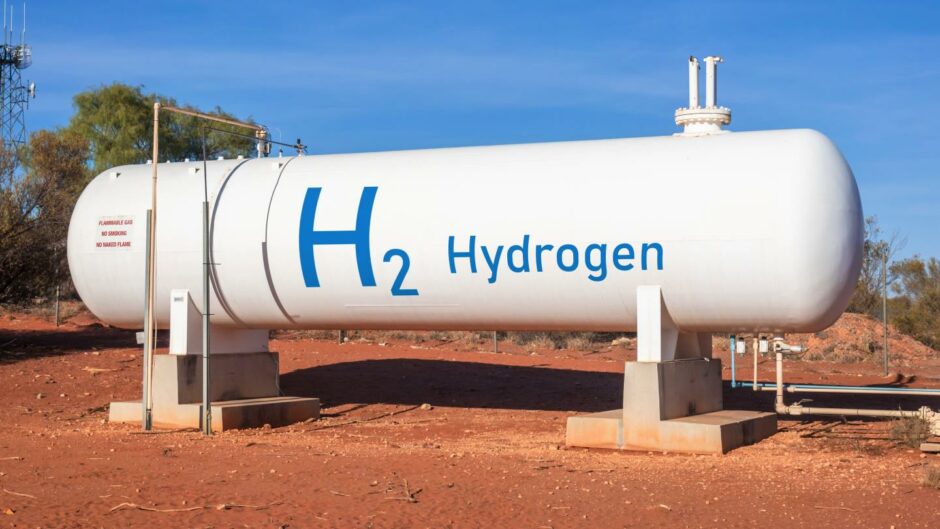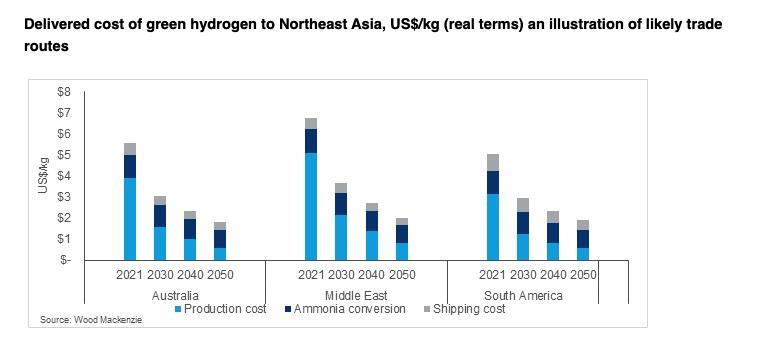
Suppliers with access to low-cost renewables will have a competitive advantage when it comes to green hydrogen production. Australia and the Middle East sit in the top echelons for solar irradiance and offer massive green hydrogen potential, according to Wood Mackenzie’s latest analysis.
With conversion and transport costs making up as much as two-thirds of the delivered cost of the expected interregional hydrogen seaborne trade, proximity to market will also be important. For supply to Northeast Asia, for instance, suppliers in Australia would appear to be ahead of the pack, said the energy research company.
“Australia, in particular, stands out from the crowd in its track record of exporting a diverse set of natural resources and minerals, sheer physical scale, solar and wind resources and substantial potential for large-scale carbon capture and storage (CCS),” Prakash Sharma, research director at Wood Mackenzie, said in a note today.
For Australia – as well as other major exporters – the opportunity to produce green hydrogen will help transform its energy export portfolio and align it with the changing needs of its trading partners. And as with Australia’s coal, iron ore and liquefied natural gas (LNG) industries in the past, buyers across Asia seem willing to invest and help develop it.
“A one-size-fits-all approach will not work. In a nascent market, hydrogen participants will need to adopt robust but flexible strategies and business models that support a potentially transformative development in the global energy transition. Today, several countries have the opportunity to harness their resources and, through hydrogen, become dominant exporters and players in low-carbon energy trading,” added Sharma.
Wood Mackenzie vice chairman Gavin Thompson said “nonetheless, while the scale of these countries’ ambition and success will affect global energy systems in an unprecedented way, the irony remains that the dynamics of the future global trade in hydrogen are likely to look like those of traditional fossil fuels. Northeast Asia, including China, and Europe will be the big importers of hydrogen; Australia, the Middle East and, possibly, Russia and the US have the greatest potential to be big exporters.”
Massive Disruption to Global Energy Trade
“The global energy trade is set to see its largest disruption since the 1970s and the rise of the Organisation of the Petroleum Exporting Countries (OPEC),” said Sharma.
“In addition to investing in renewables to slash emissions and enhance energy security, countries and industries are now looking to electricity-based fuels and feedstocks, and hydrogen could be the game changer. A key differentiator is hydrogen’s massive potential in traded energy markets. Low-carbon hydrogen and its derivatives could account for around a third of the seaborne energy trade in a net zero 2050 world,” he added.
Between now and 2050, Wood Mackenzie forecasts global demand for hydrogen to increase between two- and six-fold under their Energy Transition Outlook and Accelerated Energy Transition (AET) scenarios. Under the AET-1.5 scenario (1.5 °C warming), low-carbon hydrogen demand reaches as much as 530 million tonnes (Mt) by 2050, with almost 150 Mt of that traded on the seaborne market.
Low-carbon hydrogen import demand from Northeast Asia could account for about 80 Mt, equivalent to 55% of seaborne hydrogen trade, while demand from Europe could hit 23 Mt, or 16% of total seaborne energy trade, estimated Wood Mackenzie.
Several countries are hoping to benefit from developing export-oriented hydrogen mega projects, with blue and green hydrogen projects being developed in Russia, Canada, Australia, and the Middle East. In the burgeoning green hydrogen space, nearly 60% of proposed export projects are in the Middle East and Australia, principally targeting markets in Europe and Northeast Asia. Over the last 12 months, there has been a 50-fold increase in announced green hydrogen projects alone.
Project developers, lenders and buyers will be drawn to locations with a proven track record of exporting natural resources, suitable conditions for low-cost renewable electricity and the potential for large-scale carbon capture, said Wood Mackenzie.
Saudi Arabia, Brazil, Chile, Oman and Kazakhstan have all announced mega projects targeting the export market, while others, such as Russia and Canada, have vast low-cost gas resources and plenty of carbon capture and storage (CCS) capacity.
“While no two hydrogen export projects look the same, the most obvious difference in proposed projects is between blue and green hydrogen. But portraying this as an either-or choice is an over-simplification,” noted Thompson.
While current costs of green hydrogen production are typically more than three times higher than those of blue hydrogen, green hydrogen costs are expected to fall as electrolyser manufacturing technology improves and renewable electricity costs decline. An expected drop in costs will support a longer-term pivot from blue to green hydrogen. However, each market has unique characteristics and cost declines will not be uniform.
“The reality is that the world needs both to achieve the required pace of global decarbonisation. Blue hydrogen production has a scalability advantage over green hydrogen at present and can already be developed in the requisite volumes, though lead times are longer,” added Thompson.
“Most proposed projects are currently a combination of the two. A blue hydrogen exporter in Australia or the Middle East, for instance, could establish a market position while expanding into green hydrogen as costs decline over time and capacity becomes available. Producers could thus build out their low-carbon hydrogen supply chains as green hydrogen becomes more competitive over time,” said Thompson.
Recommended for you


 © Supplied by Wood Mackenzie
© Supplied by Wood Mackenzie